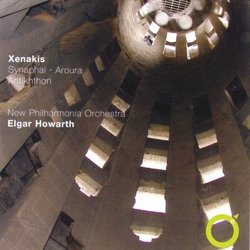| All Artists: Iannis Xenakis, Elgar Howarth, New Philharmonia Orchestra, Geoffrey Douglas Madge Title: Xenakis: Synaphai; Aroura; Antikhthon Members Wishing: 1 Total Copies: 0 Label: Explore Records Original Release Date: 1/1/2006 Re-Release Date: 6/27/2006 Genre: Classical Styles: Ballets & Dances, Ballets, Chamber Music, Forms & Genres, Concertos, Historical Periods, Classical (c.1770-1830), Modern, 20th, & 21st Century, Instruments, Keyboard Number of Discs: 1 SwapaCD Credits: 1 UPC: 878914000177 |
Search - Iannis Xenakis, Elgar Howarth, New Philharmonia Orchestra :: Xenakis: Synaphai; Aroura; Antikhthon
 | Iannis Xenakis, Elgar Howarth, New Philharmonia Orchestra Xenakis: Synaphai; Aroura; Antikhthon Genre: Classical
|
Larger Image |
CD Details |
CD ReviewsAn important Xenakis recording from 1976 from the Decca Head Discophage | France | 06/04/2008 (4 out of 5 stars) "This is the reissue of an important Xenakis recording made in 1976, in a time when there weren't so many. It was originally published on LP as Decca Head 13 and Explore records are apparently licencing a number of these Decca Head recordings - a series from Decca Great Britain devoted to contemporary music that ultimately didn't total many releases (22 by my count) but had many highly valuable ones. So far, besides this one, Explore has picked up DH 4 (Takemitsu: Corona; For Away; Piano Distance; Undisturbed Rest by Roger Woodward, Exp 0016), 6 (Roberto Gerhard: The Plague conducted by Dorati, Exp 005), 9 (Cage: Sonatas and Interludes for prepared piano by John Tilbury, Exp 004), 19/20 (Henze: "Voices" by London Sinfonietta, Henze cond., Exp 007/8), 22 (Panufnik: Sinfonia Mistica, Sinfonia di Sferewith the LSO conducted by David Atherton, Exp 0014). They've also reissued Messiaen's Visions de l'Amen by John Ogdon and Brenda Lucas (Messiaen: Visions de L'Amen, Exp 0013), but that wasn't part of the Head series: it was released on Argo, and has already been reissued on CD by London/Decca at the beginning of the 1990s, but apparently only in Japan (POCL-2348). The rest of the Decca Head catalog has been scattered around, especially on the Decca "Entreprise" series at the begining of the 1990s - including Messiaen's Transfiguration (Messiaen: La Transfiguration De Notre Seigneur Jesus Christ (Dorati) / La Nativité (Preston)), a Henze collection (Compases / Violin Concerto 2 / Apollo Hyazinthus), Berio's A-Ronne, Cries of London, a Ligeti collection(Melodien Dbl Cto), and to the best of my knowledge a handful have not yet been reissued, including Dallapiccola's Prigioniero conducted by Antal Dorati.
Coming back to this Xenakis disc: it contains three works that are among the best, most powerful and imaginative of their composer. Synaphai (Connexities) from 1969 is a concerto pitting a percussive and pounding piano against washes of orchestral color, clouds of strings, woodwinds and brass used in unusual registers and playing modes, producing "ugly", snarling sounds. The piece displays great coloristic invention and dramatic impact. Aroura (1971) for strings alone is a study in sonic textures, in which Xenakis seeks sonic equivalents to the perception of the earth's textures . The notes, by Xenakis himself, are both explanatory and absolutely incomprehensible, and what I gather from them is that the piece is meant as a catalog of interesting sonic effects - which it is - governed by certain laws - which do not necessarily jump to one's attention. But again it is Xenakis at his coloristic top. Interestingly, the explanations given by the composer on Antikhton are poetic and evocative rather than technical. The piece was commissioned by Balanchine in 1969 for a ballet and was completed in 1971 ((the notes aren't clear about this, stating only that it was after Aroura). Antikhton is the Greek for Anti-Earth. According to Pythagorean thought (claims Xenakis), there existed an anti-earth, very similar to the earth but invisible from it and revolving on an orb parallel to it, and both, as well as the sun and the stars, revolved around a central fire, made invisible to the earth by the interposition of the anti-earth. Whether the music expresses that or is entirely abstract is a moot point. But it is powerful, inventive, mineral (stark woodwinds and brass) and coloristic (strongly opposed winds and strings if I hear well), innumerable ear-catching sonic events, a fine summation of the two previous works. It could have been used by Kubrik in "2001, A Space Odyssey", alongside Ligeti's Lux Aeterna and Requiem. Of course, those who like their contemporary music with lush romantic melodies should steer clear of this recording and any other by Xenakis (and they are probably not reading this review anyway). Sonics are first rate. The CD's main drawback then is that it is a straight reissue of the LP. 43:10 might have been OK for LP, it is frustratingly short for a CD (the three compositions are respectively circa 12, 11:30 and 19:30). Normally, this would have been an eliminatory circumstance. Here, I am more ambivalent: chide Explore for the short timing, but praise them anyway for making this recording available again. I'd rather have it short than not at all. But given the timing, try and find it cheap. " |

 Track Listings (3) - Disc #1
Track Listings (3) - Disc #1